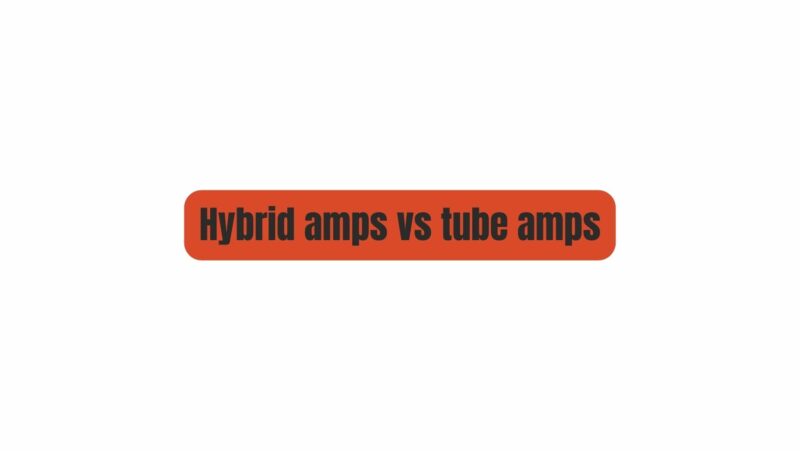In the realm of audio amplification, two distinct worlds collide: the vintage allure of tube amplifiers and the modern innovation of hybrid amplifiers. Both technologies have their fervent admirers, and for good reason. In this article, we’ll embark on a journey to dissect the strengths and weaknesses of hybrid amplifiers and tube amplifiers, ultimately helping you decide which sonic path aligns best with your audio aspirations.
I. The Essence of Tube Amplifiers
- 1. The Warm Embrace of Tubes
Tube amplifiers, often referred to as “tube amps,” have been a staple in the world of audio for decades. At the heart of these amplifiers are vacuum tubes (electron tubes or thermionic valves), which lend tube amps their distinctive sound.
- Harmonic Distortion: Tube amps are known for their harmonic distortion, which introduces even-order harmonics into the audio signal, often described as “tube warmth.” This warm distortion is adored for its pleasing and musical character, creating a unique listening experience that’s akin to hearing music through a vintage lens.
- Soft Clipping: When pushed to their limits, tube amps engage in soft clipping, which produces a gradual and smooth distortion. This soft clipping is more forgiving and musically engaging than the harsh digital clipping experienced in some solid-state amplifiers.
- 2. Aesthetic and Nostalgia
Beyond their sonic prowess, tube amplifiers are cherished for their visual appeal. The warm glow of vacuum tubes, the tactile knobs and switches, and the intricate circuitry often evoke a sense of nostalgia and craftsmanship. The experience of interacting with a tube amp extends beyond sound, creating a tangible connection to the music.
II. The Hybrid Advantage
- 1. Combining the Best of Both Worlds
Hybrid amplifiers represent a bridge between the analog warmth of tube amplifiers and the efficiency of solid-state technology. They incorporate both vacuum tubes and solid-state components, offering a balanced approach to audio amplification.
- Tube Preamplifier, Solid-State Power Amplifier: In hybrid amps, the vacuum tubes typically function as preamplifiers, where they shape the initial stages of the audio signal. Solid-state power amplifiers then take over to efficiently drive the speakers. This combination retains the desirable tube sound characteristics while harnessing the power and reliability of solid-state technology.
- Enhanced Efficiency: Hybrid amplifiers often deliver higher power output and energy efficiency compared to pure tube amps. This makes them suitable for a broader range of applications, including driving demanding speakers and serving as versatile audio solutions.
- 2. Reduced Maintenance
One of the inherent drawbacks of pure tube amplifiers is their need for regular maintenance. Vacuum tubes degrade over time and eventually need replacement, which can be costly and cumbersome. Hybrid amplifiers mitigate this issue by using tubes primarily in the preamplification stage, where they experience less wear and tear. This reduces the frequency of tube replacements and maintenance hassles.
III. The Sonic Showdown: Tube vs. Hybrid
- 1. Sound Quality
- Tube Amplifiers: Tube amps are celebrated for their harmonic richness and non-linear behavior. They excel in reproducing music with warmth, depth, and a natural compression effect, making them a preferred choice for audiophiles, guitarists, and music enthusiasts seeking an emotive and vintage sound.
- Hybrid Amplifiers: Hybrid amps combine the sonic charm of tubes with the versatility and efficiency of solid-state components. While they may not capture the pure tube magic, they offer a balance between sonic character and power, making them adaptable for various audio applications.
- 2. Versatility and Power
- Tube Amplifiers: Pure tube amps are often limited in terms of power output. They may struggle to drive high-impedance or demanding speakers. However, they excel in low to medium-power applications and are cherished for their specific tonal qualities.
- Hybrid Amplifiers: Hybrid amps provide the flexibility to accommodate a wider range of speakers and audio setups due to their solid-state power amplification. This versatility makes them suitable for both audiophile listening and professional music performance.
- 3. Maintenance and Cost
- Tube Amplifiers: Tube amps require regular tube replacements, which can be expensive over time. Maintenance demands careful attention to the state of the tubes, as they gradually wear out and influence the sound quality.
- Hybrid Amplifiers: Hybrid amps reduce maintenance costs and hassles by limiting the use of tubes to the less critical preamplification stage. Solid-state components, including the power amplifier section, are typically more durable and require less frequent replacement.
IV. The Final Note: Choosing Your Sonic Path
The choice between a tube amplifier and a hybrid amplifier ultimately hinges on your audio preferences and specific requirements. Here are some considerations to guide your decision:
- 1. If You Value Vintage Warmth: If you seek the classic warmth and harmonic distortion of tube amplifiers, and you’re willing to invest in maintenance, a pure tube amp may be your ideal choice.
- 2. If You Need Versatility and Efficiency: If you require a versatile amplifier that can handle various audio setups and speakers with ease, and you want to minimize maintenance, a hybrid amplifier offers the best of both worlds.
- 3. If You Seek a Balance: If you appreciate the sonic character of tubes but also need the power and reliability of solid-state technology, a hybrid amplifier strikes a balance between tradition and innovation.
In the end, the choice between tube and hybrid amplifiers is a deeply personal one. It’s about the sound you love, the aesthetic that resonates with you, and the practicality that suits your needs. Whichever path you choose, both tube and hybrid amplifiers offer their unique sonic signatures, adding to the rich tapestry of audio amplification options available to enthusiasts and professionals alike.


